I'm brand new to making music and I'm interested in hearing about how different people approach composing for their games. Not in terms of using the music editor—I'm fine with that—but more about your process/workflow for creating the music itself. You can assume that I understand about scales/modes, keys, chords, chord progressions, etc. and feel free to sling around jargon/technical terms if you want I can always go look up anything I don't understand.
I realize that everybody goes about things their own way; I'm not looking for a "right" way to make music, more just interested in peeking into people's brains while I try to figure out my own way of doing it.
The kinds of things I'm interested in (not an exhaustive list!):
- How do you start? With the main melody? With a beat? Chords? Something else? Do you always start the same way or does it depend? On what?
- Do you create your music from scratch directly in the PICO-8 music editor or do you use something else, like a DAW and then "translate" the music over into PICO-8?
- Do you have particular modes, chords, or whatever that you use regularly to get that characteristic video game-y feel? Any that you avoid?
- Any other tips/tricks you think might be useful.
I'm interested in hearing from anybody who feels like sharing whether you have a formal music background, are self-taught or just throw a bunch of random notes together until something sounds good.
I myself have zero formal music background and was mostly never really "got" music. Don't get me wrong, I like music well enough but it's always just kind of been a thing in the background. I might know all the words to a song but not what the song is called or who performs it. Fairly recently I started playing around with LMMS and found that, in fact, making music tickles my dopamine receptors and is pretty addictive. So I've been deep diving and learning all I can.
I can do individual things, like write a melody or a chord progression, etc. but the big picture where it all comes together eludes me. Ultimately the solution to that is to learn more and make/practice (much) more but, in the meantime, let me know how you do it!

For me, I just Google something like "sad chord progressions" or "upbeat chord progressions" and throw some of the results into the editor to see how they sound, then tweak specific notes, tempos or instruments until it sounds like what I want. Either that or I sorta try to recreate a known song by ear, like the version of "Take Me Out to the Ballgame" I used in Unsafe at Home. I am a musical dunce, so my "compositions" probably induce seizures in someone like Gruber, but in the end I want to feel like I've stepped out of my comfort zone and created something that's all me, janky sprites, discordant squawks & everything :)

For game music I try to let the game itself suggest mood, genre, tempo, rhythm. I noodle on the major ideas in my brain, mostly in the shower—though I'd much prefer to develop a discipline of iterating at an instrument because doing it entirely in-head is slow and tends to ossify mediocre ideas as I try to memorize the bits I like. Sometimes I'll write down melodies and chord progressions as part of that, then turn to PICO-8 mostly for "implementation."
Bass, rhythm, melody, harmony. You can often put rhythm instruments between notes on one of the other tracks, e.g. by only using harmony accents off-beat, or not sustaining bass notes. I tend to get greedy with rich harmonies and full sounds, so a short song can really eat up pattern space. I like at least a verse and a chorus, and like to trade away game sfx for a C section. ABABC is usually all I have room for in the end.
I like to think of the game itself as a sort of musical instrument that the player plays. At the very least, I want the player playing along with the music. I have yet to do a PICO-8 game where I've done much of this, but I like how game sound design works with game music design, e.g. intentionally compatible or incompatible keys and harmonies.
I have three PICO-8 examples (all collabs with @TimSwast), all Christmas-themed because I don't have enough of a work ethic to finish anything any other time of year:
-
Santa Panic (2018). Motifs from xmas songs set in a too-fast circus-y frame, starting with the opening to Leroy Anderson's "Sleigh Ride," intended to be lightly panic inducing. I accidentally stumbled into an auditory illusion in the final phrase that feels like it's speeding up even though it isn't. Technically it's more of a harmonic error but I like the result. Lots of major-7s because xmas, especially riffing on "Christmas Time is Here" by Vince Guaraldi, which is quoted directly in an ornament on the second verse. The first five notes of the melody are accidentally lifted from the intro of "Love I Hear" from A Funny Thing Happened on the Way To the Forum by Stephen Sondheim (another major-7 though it quickly gets much more sophisticated in the original, because Sondheim). The level-intro jingles reuse patterns from the main theme because I used up all the pattern space. I wanted something like a sitcom act intro, so that's appropriate, though I would have enjoyed ending those on an unresolved chord like a a IV or vii.
-
Snowy's Skating Adventure (2019). Trying very hard to be the opposite of Santa Panic, we were going for the stillness and calm of outdoor ice skating, something you could luxuriate in—which is funny to think about in retrospect because the end result is rather maddening and cacophonous. Simple complementary themes, introduced almost arhythmically between objectives. Major-7s again. I wanted the finale to feel like a reward, so the game ends with a glitzy up-beat re-interpretation of one of the themes. The finale includes a 3-half-step modulation (my favorite modulation) as a surprise. I doubt anyone ever played through to the end.
- Dr. Santa (2020). I saw how the game pieces fell and wanted to swing the rhythm, so it's rock-swing triplets throughout, with the game rate adjusted to match. Swing is a pain to do in a 16-beat tracker without a built-in swing feature, but worth it. I can't remember if the meter of the phrase "Doctor Santa" (DAH-da DAH-da) inspired the swing rhythm or if I just noticed it afterward, but I privately gave the track the title "Save Me Doctor Santa (the theme from Dr. Santa)" and I like to pretend it has lyrics. This seems like a good trick for melodies in general: make them singable. I'm not fond of the verse melody in this one, though mediocre melodies do have a vintage arcade feel. I like how the chorus kicks it up a notch, then a double-punch with a short C section (bridge?). I have mixed feelings about how much time it spends on the tonic but I actually think that's a benefit for looping themes with long play times. Some of my favorite game music loops, like the hub worlds in Mario games (esp. Paper Marios, Sunshine), are more listenable for how much they don't modulate.
I'm not sure these are the best strategies for PICO-8 games, but I like how they just fit. As with all of PICO-8, the limits cut out some of the intimidation of more powerful tools, and encourage creativity. I'd love to try something more minimalist in the orchestration so there's room for more musical themes across a longer game.

chipping in here, i fall in your last category of "just throw a bunch of random notes together until something sounds good"
i have an extremely difficult time designing music in my head so i don't get to envision what i want the final product to resemble like i can with something like drawing, so this may influence my possibly strange workflow
the first thing i try to do is make a chord progression, since it's relatively easy to do that by trial and error. i like to have chords build up to a bold sounding chord in the middle and then go back down so it can loop again. chords aren't super feasible in pico8 due to its limited channels but you can use arps, instrument 0 with detune 1 or 2, or just a single note, maybe as a bassline.
from there i can write a melody. i do this by placing a bunch of notes with the same pitch and try to find an interesting rhythm. once i do that i start moving the pitches up and down, generally trying to have the same notes as whats on the chord but not strictly
as for arranging multiple pieces together in a flowing, cohesive song.. it is a mystery to me lol. but my other strategies might be helpful
one last thing that i discovered by looking at other tracker songs, you can make an echo effect with no extra channels by having a gap between every space and set the note of each gap to be the same as the note three spaces previous but with a lower volume
i realize i probably didn't explain that well so im adding an example
[sfx]

I have a hard time with this but when I made the music for my pico-8 games I tried to get sfx instruments that I liked, and then from there try different ideas that came to me till I liked it. sometimes reusing a motif in multiple songs can feel really good as well.

For my part, I'm rarely writing for a purpose, so I usually start with some relatively arbitrary idea and then just follow my ears wherever they like? The times I have written specifically for game projects, real or imaginary, what I've thought about has been a mixture of:
- creating an appropriate vibe (for example, a piece that's generally pleasant and sweet, with no deep well of anxiety under the surface) (I might be an anxious person) (as in I've literally been diagnosed as such professionally),
- maintaining interest over a long time (don't use a ten second BGM loop if the player is going to be hearing it for hours, please, I'm begging you),
- staying within a SFX/music pattern budget, and
- evoking vaguely related sound effects (card-shuffling for a solitaire game, meteorite impacts for a game taking place on a lunar surface, washing machines in a laundromat, that kind of thing).
That last is the only one that tends to become a seed for the music to blossom out of? Often I have to just make up an arbitrary bassline, melody, rhythmic figure, chord progression, or whatever else and decide after it gets started if it'll work.
Re: 2: I usually create it all directly in PICO-8 (I like to try to aim for equal or fewer SFX than music patterns, just to leave room for game SFX? and composing in PICO-8 naturally aids in doing that) but I might try improvising melodies in LMMS and then transcribing them. That seems like a good way to get inspiration.
Re: 3: I actually don't try to make anything I write sound videogame-y? Except as maybe a "heck, why not, it's fun" relatively arbitrary inspiration, maybe. The classic videogame composers weren't trying to sound like videogame music, they were using their knowledge of music they liked and finding ways to adapt it to the tools they had access to. I don't think it has to sound videogame-y, it just has to sound right for this game.
Re: 4: A-section, B-section? Andrew Huang talked about this a while ago in a video about extending a work-in-progress closer to being a full track, but the whole idea of "change something and keep something the same" has been really useful to me for extending a shorter thing into a longer thing. Sometimes that's dropping out one voice (melody, drums, bass, whatever), sometimes that's dropping out everything but one voice, replacing one instrument with something else ... holding something over while changing other elements. Go from "here's a chord progression with some syncopated lines on top of it" to "here's the same chord progression but you drop out the percussion and have these long held notes" or whatever. That feels like the biggest single thing with regard to videogame background music loops, is shifting to a different kind of soundscape for a while before looping back.
Edit: Andrew Huang actually more recently made another video about building up from loops into full songs - more focused on traditional pop tracks than, like, videogame looping background music, but there's some good details of thought process in there.

Thanks for the replies everyone. Sorry I haven't had time to respond sooner. I'd still love to hear from more people if anybody wants to share their process.
@2bitchuck, I quite like your rendition of "Take Me Out to the Ballgame." It's funny actually because when I got interested in PICO-8, Unsafe at Home was actually one of the first games I played. I somehow didn't clue in to the baseball theme based on the title or title image and thought it was going to be something horror themed. Then I saw, "baseball bullet hell" and was too intrigued not to try it. Really fun!
@dddaaannn, Those are all great! The Santa Panic one in particular definitely hits that mildly anxiety inducing feel, at least for me. You'll have to add me to the list of "not played through to the end" of Snowy's Skating Adventure because, apparently, I'm as good at skating in the game as I am in real life.
"I try to let the game itself suggest mood, genre, tempo, rhythm."
Yeah, this is something I'm having trouble with. I think just because I'm still so new to making music at all I don't really know how to musically express the things I'm trying to express just yet. I know when I've gotten it wrong but I haven't yet figured out how to get it right. Practice, practice, practice, though, right?
"You can often put rhythm instruments between notes on one of the
other tracks"
I had thought of something like this, just sprinkling drums or whatever across all the different tracks so even if it ends up obscuring notes it won't obscure them all from the same track and the remaining track would, hopefully, fill in enough of the texture that a missing note here and there wouldn't be noticed too much. Maybe also with a fade-in on the following note so it's not such a harsh change? Have to play around with it for sure.
"As with all of PICO-8, the limits cut out some of the intimidation of more powerful tools, and encourage creativity."
For sure. I actually am using a DAW because I can't quite picture what's going on with the music in the PICO-8 editor. With the DAW I can see the intervals, I can see how the chords change and flow into each other and, at least for now, that really helps. But I do try to restrict myself and keep it simple. I just keep everything on the piano since I figure, if it sounds okay on the piano it'll sound okay on just about anything else. That's my working theory anyway. And I try to stay mindful of the fact I'm only going to have four channels to work with. Unless I'm trying to make non-PICO music and then I'll throw in whatever tickles my fancy.
"i have an extremely difficult time designing music in my head"
Me too! In particular, I'm having a hard time fitting a rhythm or a melody—or both—to the kind of mood/feel I'm going for. I also find it easier to start with a chord progression then add a bit of variation to the chords themselves, sometimes by using a different inversion somewhere or sometimes just cutting the chord into smaller pieces and playing it twice (or more) to give the chord progression itself a bit more rhythmic interest than just: block chord, block chord, block chord, etc. That kind of helps me lock into an overall rhythm.
@SmellyFishstiks, I kind of keep forgetting that the SFX instruments are an option and I haven't even tried making my own yet. Your comment also got me to try starting with a rhythmic and/or melodic motif, sprinkling it around and then figuring out the in-between bits which is giving me some good results, so thanks for that!
"don't use a ten second BGM loop if the player is going to be hearing it for hours, please, I'm begging you"
Oh yeah, I feel this! I'm still mostly at the stage of making small loops and haven't really figured out how to make bigger things and stitch them together in a satisfying way and I've already lost count of the number of tracks where I start off thinking, "hey, this isn't bad, I kinda like it," right into, "oh god, make it stop!" after working on it for ten minutes.
"I actually don't try to make anything I write sound videogame-y?"
I'll admit, when I first wrote the post I hadn't really tried moving stuff over into PICO-8 and was only working in LMMS trying to figure out how to make it sound game-y. After reading your post, I opened up one of my files, transcribed it into PICO and...yeah, basically no danger that it's going to sound like anything other than a game no matter what I do, which is great. One less thing to think about!
Also, thanks for the video links. I hadn't come across Andrew Huang's channel but I'm glad you've introduced me to it.
For myself, I've been playing around since I posted this and here are some things I've figured out for myself.
- As mentioned above, I find it easier to start with a chord progression, add a bit of rhythmic interest to it and then go from there.
- I find it easiest to start by thinking of each SFX pattern as 4 bars worth of eighth notes and going from there.
- Maybe as a result of how I write chord progressions, if I write a chord progression across three channels, one each for the top, middle and bottom note of each chord—not necessarily the 5, 3 and 1 notes of the chord, because inversions—and then play them individually, there's usually at least one which makes a decent starting point for a melody. Not necessarily a good melody on it's own since it just follows the chord exactly (obviously) but a good starting point. And often they're all pretty good with slight variations and subtle shifts in mood/tone.
I've been enjoying playing around in the phrygian and locrian modes and even in other modes I like mashing on those diminished chords for the slightly dissonant sound, which maybe says unflattering things about my state of mind after nearly two years of pandemic. But anyway, some examples. Apologies if I torture any ears, I am still very new to this.
Each row is a single chord progression. The first three patterns on the row are the top, middle and bottom notes of the chords played individually. The fourth pattern is the whole chord progression together.
The second row is over two bars instead of just one. And on the thrid row everything cuts off after three bars because when I was originally setting it up in LMMS I apparently forgot how to count to four.
The fourth one is happy! I think! After the chord progression I wrote a separate melody to go over the top which shows up in the last three patterns on that row. In LMMS on the piano everything together sounds pretty good. Here everything together sounds a bit...claustrophobic? Anyway, whatever. Here ya go!

@jasondelaat Aw man, thanks, I really appreciate you saying so! It's funny, my wife is a musician, so I hear "Are you sure that's right?" a fair bit when doing this stuff, but most of the time I just go with what sounds right to me, whether or not it's actually right :).

Glad to be of help! I'd not played any music for, like, sixteen years before I got a copy of PICO-8, and making stuff in the tracker was really inspirational for me.
Re: your second example music post:
> Okay one more. Fun but extravagant waste of pattern space.
It's not really extravagant? You've used four SFX in two patterns to make essentially the treble line of the arrangement, and that's something you can repeat while other things change. Maybe bring in a bass voice. Maybe do some arpeggiated thing in a middle voice. Maybe make copies of the second-channel SFX with percussion and switch them out. If I were writing music right now and had these four SFX in these two patterns, I'd build an A-section that's eight or twelve patterns long out of repetitions of this with variations in the other voices and then go into some kind of B-section.
For real and honestly, I could probably make a sixteen-pattern loop starting with those four SFX and not use more than sixteen or twenty SFX. It's a nice starting point for something.

As far as this goes:
> Not necessarily a good melody on it's own since it just follows the chord exactly (obviously) but a good starting point.
It is, yeah. Honestly, with only four channels, playing two or three chord tones in the melody voice takes pressure off the others to fill out the rest.
Something you might try to spice up your melodies with non-chord tones is passing tones? Or technically they have several names - another of my favorite music-related YouTube channels, 12tone, did a video talking about different ones in the context of naming a couple that didn't have official names - but the idea is connecting your chord tones with other notes that don't clash too hard because you're not hanging on them for a long time.
I mean, you can also intentionally sit on non-harmonic tones just to enjoy whatever that ends up sounding like, but using non-harmonic tones to connect your chord tones is a good strategy.

"It's not really extravagant?"
That's actually really good to hear. Dedicating 2 SFX to just 8 notes feels like a waste of space but I don't have any real sense of how much space might be needed to create a longer piece. And of course, in retrospect, it's seems obvious that I don't actually have to leave that space empty. So yeah.
"playing two or three chord tones in the melody voice takes pressure off the others to fill out the rest."
Yeah, actually I got the idea after watching this video by 8-bit Music Theory—most of what he talks about in his videos goes way over my head but I understand just enough to keep watching—about the Super Mario series and how a lot of the melodies are mostly chord notes with other notes just used to fill out the sound a bit or connect phrases or whatever.
Anyway, thanks again!

Okay and last one from me and then I'll stop spamming my own thread.
Started with a chord progression, separated out the top, middle, bottom notes of each chord and then combined and re-worked those bits into a lead melody and a bass melody. The lead melody goes where it goes and I'm counting on the bass melody to mostly carry the root note of each chord. That used up two of my channels so my "chord progression" becomes just the 3-note of each chord. And finally some percussion-y stuff which kind of doesn't fit but it's a start.
If anybody has tips on how to deal better with volume I'd love to hear them. The high pitches come across as very loud and ear-bleed-y but they're already at volume 1. I could probably move the whole lead melody down an octave, which might help, but then I'd be worried that it would just get lost with everything else.

So, there's probably an element of "I don't mind piercing notes as much as some people do", but I think part of that piercingness is actually that the notes are constant in volume?
Like, in your original, the volume of everything is 1 ... which means that notes are either on, fading out, or off. With this:
I bumped up the volume of everything but the noise percussion and the melody to 3, set the noise percussion to 2 because it felt too aggressive to me at 3, and then shaped the melody notes. Like, here's the first melody SFX:
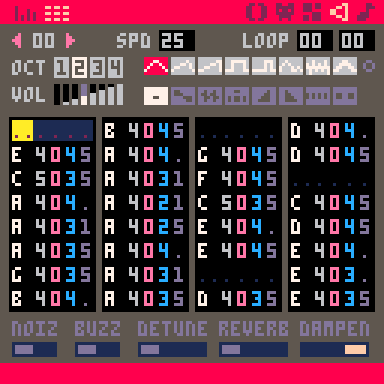
Essentially, each note starts at a 3 or 4, but if it's held for more than two lines, I use the slide effect to ramp down from there until the fadeout. In the second column, for example, the first A4 starts at volume 4, slides down to volume 3, slides down to volume 2, then fades out from volume 2.
What this means is that everything is louder, but within that loudness, the melody notes are less intense - most acoustic instruments will start at one volume and then get softer, and shaping the tails of the notes makes that effect.

Unrelatedly - and this isn't my best work but maybe it shows off the idea - you can build longer, not just with more voices at once? Like, I added one SFX to this:
...and it's three times as many patterns, because you can repeat things pretty freely if there's variations in the repetitions.
Talking through my thought process, because I figure that's what this thread is about:

That's great, @packbat! Thanks for talking through the process it's really helpful.
I had actually planned to put together a longer piece before posting it but the volume issue was annoying me so I just posted the main bit and left it at that. I actually wrote both the main melody and bass melody in two parts, each of which loops well with itself as well as with the whole. So you could repeat the first half a couple times, then maybe the second half a couple times, the put the together, drop out everything but the bass then bring it all back in again, etc.
I start with things in LMMS and then transcribe them into PICO-8 and I actually like the original enough that I kept messing with it. I've gotten about a minute and a half of music out of the basic bits just varying the chords, or repeating motifs from the melody, and so on. I wouldn't go so far as to say it's good but since I've only been doing this for about two weeks—my wife's out of town for a couple weeks and we don't have kids so I've been following all the rabbits down all the holes—it's a lot less bad than it has any right to be.
Anyway, thanks again. I really appreciate all the feedback it's been immensely helpful!

Sure thing! I'm glad things have been working well!
Honestly, it sounds like you're doing the process - make something, listen to it, decide what you think of it, and keep working. If you're at the point of making stuff, you're already well on your way, so keep doing it.
(Also: all those music theory videos you watch? I'm betting if you go back to those after a couple months of work, you'll learn so much more from them because you have context now.)
Last thought, something that's been super useful for me personally: a separate folder for works-in-progress and abandoned ideas. I might have a hundred fragments and iterative stages that might someday become something versus twenty completed works - having a way to find the things you finished and like is really nice.

Oh shoot, I just remembered: 8-Bit Music Theory did a video earlier this year on writing drum parts, and while it's focused on writing drum parts for live drummers in a context without the four-SFX-channel restriction PICO-8 has (I have never in my life had a hi-hat on all four beats in sync with a kick and snare pattern), it was still really helpful to me in thinking about percussion for PICO-8 chiptunes.

Oh that's great, thanks! The video has come up in my feed a few times but I've kept passing it by for one reason or another. Just watched it now though and it is super helpful.

Hi Jason. I've been a musician all my life, in some capacity. I play many instruments and have been in all sorts of bands at varying levels of professionalism. I've also been making electronic music, kind of left-field stuff, for about 25 years now, and am just having some fun with the Pico-8.
What I've learned is that simple is best. If you have a solid backbone (usually drums and bass-line), you are golden. Melodies are what most people focus on, but they only can breathe and play if there's solid ground for them to ride on.
Here's some tracks I made for a game I'm about to be finished with, and some tips about drums, bass-lines, and melodies.
First here's the title screen track:
[sfx]
It's just 3 chords, then a simple beat comes in on top. The kick drum sounds like a heartbeat at first, then a skip-step on the high-hat and then just solid high-hat clicks. Nothing more is needed. It builds suspense and gives character, and no melody in sight!
You can see there that many of these sounds are green ones, meaning they are custom made instruments. For pretty much all my tracks in this game, I use the same bass, kick-drum, high-hat, and snare sounds.
Bass:
Bass-lines should be simple, no more than a few notes, and can repeat a lot. No need to be fancy here, though sometimes a funky complicated bass-line can make a track. This is the backbone of all the melodic parts of your track. Let it guide what the melodies do, not the other way around.
I make this bass sound get super deep. Deeper than the lowest note allowable on a normal instrument. This is how:
I set a custom instrument and give it the lowest note, C0. I give it instrument 1 so it has a little grit, and have it loop that first note. When I would use this custom instrument, middle C, C2 will play this note. Therefore, if I use a lower note in tracks that use this instrument, it will pitch it down even further, allowing me to get notes 2 octaves lower!
Here's a screenshot of the custom bass instrument:
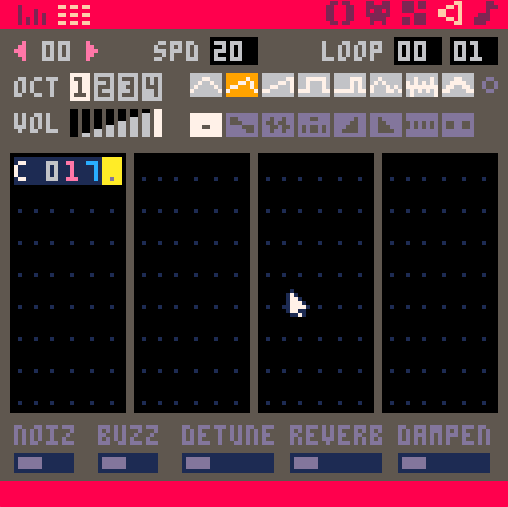
Here's another track that uses it for some low bass tones:
[sfx]
Again, this track is very simple. One bass-line with 8 notes (only 4 distinct tones), some drums, and a two note melody, if you could even call it that. It may not keep the attention long on its own, but it's background music. And background music shouldn't distract you from the action of the game. In-game, I have it repeat three times, then fade out into another track.
Drums:
Kickdrum:
Kick-drums should either high-light the bass-line, or provide the main rhythmic element of the track. It's what you feel in your chest and lower body when you dance, and guides all the movement.
A good kickdrum sound is a simple sine-wave (main instrument 0), with a drop (effect 3). Around D1, or anywhere in the 1 octave is a good starting place. Lower sounds too deep and doesn't have punch. Higher sounds like a droplet. I want mine to always drop fast, no matter how fast/slow my song is, so I have a custom instrument where the speed is 12. This ensures the kick-drum always hits the way I want it to. I put heavy dampening on it to sound deep and have it cutoff after 1 note.
Here's the custom kickdrum I use:
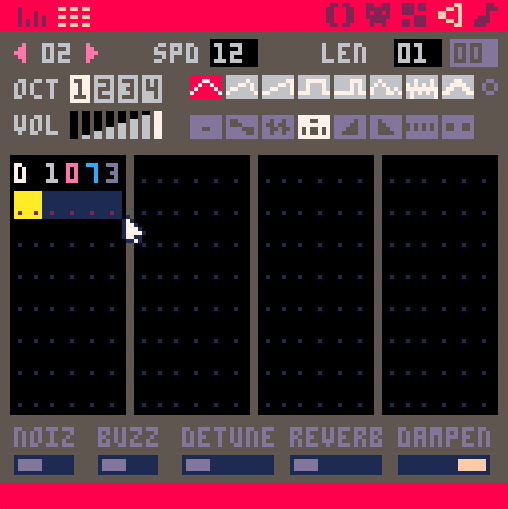
High-hats:
High-hats are often best left as straight 8th notes or 16ths. Accent some of them (make them louder or different pitch) to make it interesting. Throw in an open one for interest and grooviness. This is what gets your head in the groove.
I like my high-hats tight and fast, so I make a custom instrument with a fast speed, like the kick-drum, no matter how fast or slow my track, my high-hat is consistent. With the noise (instrument 6), the pitch affects volume and harshness, so I keep it low to prevent my hats from being too sharp. It also cuts off after 1 note. For an open high-hat, I use the noise instrument with a longer fade, or sometimes a fade-in (effect 4).
Here's my custom high-hat I use everywhere:
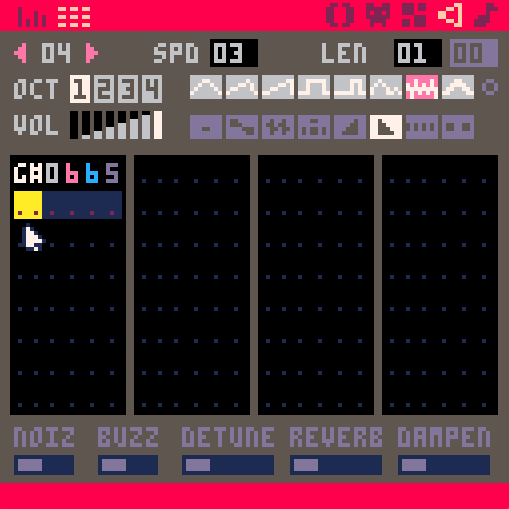
Snares:
Snares are usually just put on the 2 and 4, or on the 3. However, some accent ones make it interesting, and putting them all an 8th note late or some other offset gives a track a lot of flavor. Experiment with it, but don't overuse the snare. 1-3 hits per bar is best.
I like my snare to hit hard and tight. It's similar to the high-hat, except slower to fade, higher in pitch so it punches, and with the detune2 effect and some dampening for character.
Here's my custom snare:
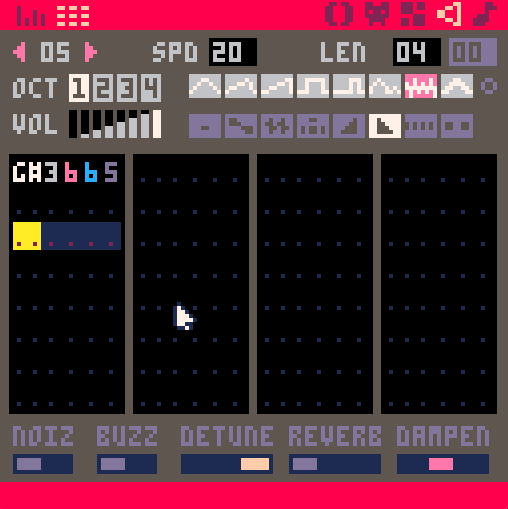
Put 'em together:
Here's a track that uses all of these drum elements and the deep bass:
[sfx]
Again, quite simple. 1 bass-line, two drum patterns, and this time a set of arpeggiations as glitchy chords. Still not really a melody. I think this one slaps.
Melody:
The main tactic for melodies is K.I.S.S. (keep it simple, stupid). However, a lot of chiptune artists tend to go wild on melodies, but doing so will ensure you can fit one track per cart. By minimizing the melodies, I'm at 6 tracks on my games cart, with space for 2-4 more.
Sometimes you can use little tricks to make a simple melody seem complicated. One method is differing the loop lengths. Philip Glass uses this a lot.
Here's an example. The melody loops every 24 notes, while the rest do at 32:
[sfx]
Really, though, there are no rules when it comes to music. Just try to make it flow. Unless you are intending to be avant garde, it should have some sort of flow and cohesiveness. This doesn't mean it can't have parts that are opposite to each other. You can have slow-meandering parts on top of fast, twitchy parts, as long as it is cohesive.
Here's an track that starts slow, and keeps a slow chord structure, but has a fast beat:
[sfx]
Anyway, I hope this stuff was useful to you. I hope you have a blast playing with music. Stick with it, even if it feels frustrating at times. It is such a rewarding thing and you will thank yourself for making it a part of your life. Good luck!

@UnitVector
Thanks for taking the time to put this together and going into so much depth, it's really appreciated. I've not been adding much in the way of drums to my Pico-8 stuff because I've not really been able to get them sounding right so your whole section on drums is particularly helpful!
I really like that title screen music. It's making me want to play the game and I don't even know what the game is.
I'll have to copy these over into a cart so I can take a closer look at how you've put them together. Lots to digest here, looking forward to it. Thanks again!

If you go to my profile, I've posted the cart. It's called "Orbital". All of these tracks are on it, plus one more I didn't post. If you get the cart, you'll have them all to look at.
Oh yeah! A few other tips:
- Silence is just as important as sound in music. Leave spaces between notes/beats. They give the rhythm. Don't fill every note.
- Notice how some of my patterns seem to repeat four times before moving to the next pattern? That's because I include the 4th channel as a much longer empty track. I make the others loop and that one not, so it won't move on to the next pattern until it gets to the end of that longest track. This will help you get a lot of music out of a few patterns. Music usually repeats anyway. Use that!
- On that same tip, some of my bass-lines are 4 measures long, while the drums are one. I just have those parts repeat until the bass-line is done. I knew I wanted the bass-notes to be long, so instead of using 4 patterns I use one and have the drums repeat 4 times. Space-saver!
- BIG TIP: Take breaks. Come back later. Listen with fresh ears. If you sit and listen to the same patterns over and over again, you become numb to it. The bad parts start to sound like they fit, even when they don't. Your brain will do this to you. It wants things to make sense, and will make them make sense even when they don't.
- HAVE FUN!

Mixing different SPD values across different SFX is super useful, yeah. In general, the longer you make the duration-defining SPD values for your tracks, the more time elapses - and mixing SPD values lets you get the faster rhythms without giving up that duration.
On a similar note, a trick I've experimented with a few times is a melodic custom SFX instrument. If I want to work at, say, SPD = 40 for the overall track, I'll make an SFX in C (usually) with SPD = 20:
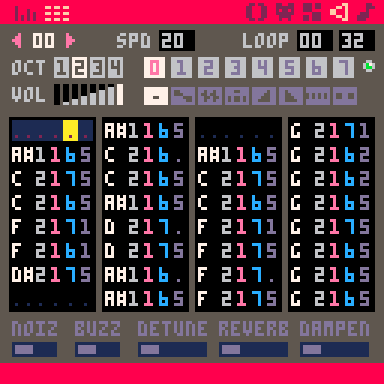
(note how there's syncopation on the SPD = 20 subdivisions that are inaccessible at SPD = 40, and also glides that would be much slower at SPD = 40 but are pretty quick at SPD = 20)
...and then I'll play that in whatever key my piece is in in a SPD = 40 SFX:
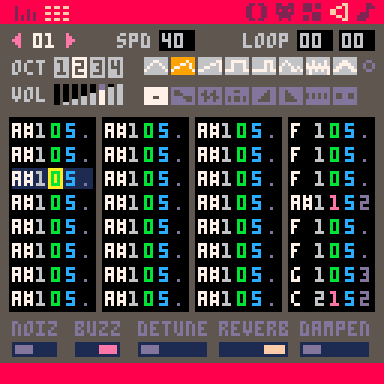
...which lets me create variations on it. (And take advantage of accidental details - at the next-to-last line, I wanted a glide up to a different pitch, and there happened to be a glide in the actual SFX right there if I just put an effect-3 don't-retrigger effect on it.)
This is very much a "compose in PICO-8 and let the technical limitations inspire you" compositional strategy, but it's real fun when it works.
Edit: It does also ask you to think about keys and transpositions a bit more - I went down a perfect fourth because two keys a fourth apart usually share a lot of notes and going down a whole step sounded weird, for example. And I had to figure out what notes were playing when I went from the melody instrument to new notes, manually entered. That said, it's a fun technique.
[Please log in to post a comment]










